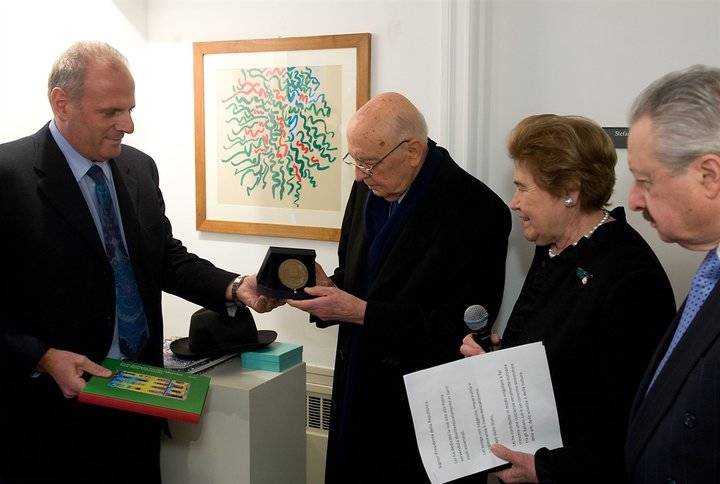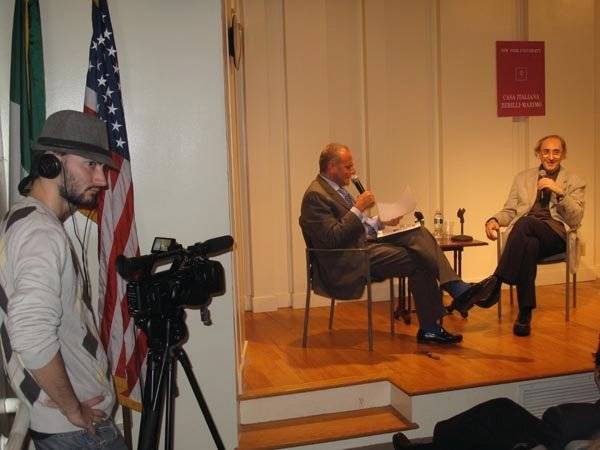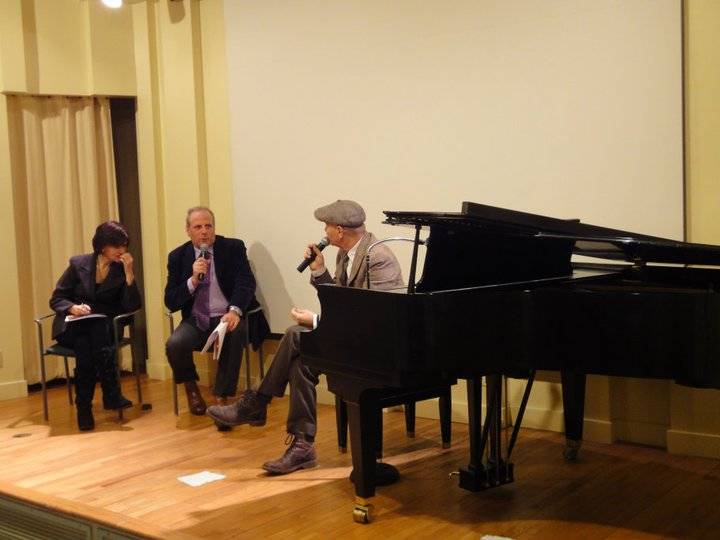A Casa, with Stefano Albertini
It is a pleasant recurrence for i-Italy to take a look at NYU Casa Italiana’s programs together with its director, Stefano Albertini.
The building in the Village, where the institution is situated, was bought 21 years ago by Baroness Mariuccia Zerilli-Marimò and donated to New York University. The mission, grandiosely achieved beyond all expectations, was to give New York a place, a house in this case, for Italian culture.
I go there frequently and every time I walk through the doorway I can’t stop feeling a sense of deep welcoming, liveliness and warmth: I’m home.
Its walls practically speak, because there is usually an exhibition on view that takes one back to Italy along Casa’s corridors. If one arrives during academic hours, students of all nationalities are walking around carrying their books and laptops from one room to another, stopping to study in the library or in the garden, weather permitting. Towards the evening a more mixed group of people fills the auditorium seats.
And Stefano Albertini, the director, has left his fingerprint on all this. Together with a staff of young Italians and Americans, he is the metteur en scène of a difficult story: the Italian culture for Americans.
I find him in his office, among books, catalogues, photos and paintings, in front of his Apple on which he contacts his collaborators through Skype. He appreciates communicating with Facebook, knowing that it is easier to reach the younger generations there. While speaking to him, his email alerts ring frequently.
His doorway has been crossed by well-known Italians and Americans as well as lesser-known young talents who keep American-Italian relations alive.
We speak of culture with him, politely, but outspokenly.
Albertini begins by highlighting the recent activity of this 2011-2012 season:
“By now our programming has achieved a pretty consolidated rhythm. We have a few fixed events such as Open Roads with Antonio Monda and Lincoln Center, our collaboration with the Penn Festival, Fred Plotkin’s series on opera, Grazia D’Annunzio and Eugenia Paulicelli’s on style, fashion and design, just to name a few.
Then we have a great number of activities that change every year. This fall, for instance, we have the luck to host, over ten days, two of Italy’s most important writers. One represents the extreme North of Italy, the North-Easterner Claudio Magris. He is a great theorist of Mitteleuropa and of the Asburgic importance for a great part of central Europe that extends into Italy. The other is Erri De Luca, a Neapolitan writer of great spiritual inspiration.
The other aspect that brings together some of this semester’s activities is a sort of journey and exploration in Italian popular music. We had Canzoniere Grecanico Salentino that possibly represents the excellence of Apulian popular musical culture from pizzica onward. We will have a performance of Sicilian popular songs dedicated to the sea with Michela Musolino and a band created just for this occasion. We will be hosting a male choir from Nuoro presenting the great Sardinian musical tradition. We will also be journeying through the Italian choral tradition beginning with pre-Gregorian chant, moving onwards.
We felt it would be important to rethink Italian popular music, the folklore, in a period of great rebirth due to a series of experimentations, collaborations with rock, pop and even electronic music.
And Casa is always inhabited by beautiful exhibits…
During this semester we have two very important exhibits. They aren’t of contemporary artists. The one that just closed was on the fortified villas of northern Italy, with wooden models.
The next exhibit will be about Hemingway’s presence in Italy, especially in Veneto. It will be a collection of very beautiful black and white photographs that document the Italian lifestyle of one of the greatest American writers of the Twentieth century. It will be like entering his mental landscape, Venice, and the whole of Veneto.
Next semester we will return to contemporary art. We are working on a large exhibition on Licini together with the Italian Cultural Institute.
We are also preparing other events regarding cinema and photography. I can anticipate that we will be bringing “Margini d’Italia”, a very beautiful exhibit put together by our colleague David Forgacs, chair of Contemporary Italian Studies. It is about the different aspects of marginality in Italy, from immigrants to the working class, etc… A very different Italy from the one shown on postcards. We feel it is a good idea to show all the different aspects.
Different aspects… it isn’t always easy to talk about our country.
I think that in this job there are moments during which one has to take a deep breath with regards to contemporary Italy, and this is one of them. The fact that we are not there helps to move a bit beyond, to explain our country and this is especially clear to a journalist like you who writes for readers across the ocean.
Any other upcoming events about contemporary Italy?
Apart from the highly awaited conversation with Beppe Severgnini, who dedicated his last book to explaining Berlusconi’s Italy to Americans, we will have an event called “Why Italy Matters to the World”, organized together with a group of Italian professionals in New York.
It will happen in mid-November. We will work on researching American investors for avant-garde Italian start-ups. I think it is our duty to offer possibilities to young businesses in Italy.
I say this because, after this crisis, there will surely be a better time on the wave of a younger and braver entrepreneurial class.
So we try to look beyond the crisis and prepare for possible ways out.
But the crisis unfortunately is not only financial, in our country…
We can’t hide the fact that we are in a moment in which it is difficult to talk about Italy. Recently it has been represented in the States as a sort of joke. We are mentioned by stand-up comedians instead of by serious news. All this makes our job more difficult.
But stirring things around in this solidified cauldron is not a way out. Here at Casa Italiana we have the advantage of living outside of the Italian swamp and can look up.
Casa Italiana is becoming more and more a place for dialogue about all things Italian in New York. As we said in another interview we made two years ago: a ‘free arena’ open to everyone…
I can safely say that all political and cultural forms have the possibility of expressing themselves at Casa Italiana. Our gatherings are always open-minded and sincere. I remember when we hosted Letizia Moratti when she was Minister of Education and Scientific Research. She asked to meet Italian researchers and an Italian functionary asked me to only invite people who wouldn’t raise questions. I answered that we don’t choose, that everyone is equally a colleague and that everyone would have the same right to speak. What turned out was a very lively encounter, with strong points of view, expressed with great fair play. I think that this is the key. By not censuring, debate cools off.
What we can do is offer a platform for democratic debate on which everyone can express his or her own idea. The same thing happened when we hosted Nichi Vendola, president of Apulia, a controversial leader of the Left.
There have been many “memorable” visits: above all the visit of President Giorgio Napolitano. I will never forget the moved faces of Baroness Zerilli-Marimò and Stefano Albertini.
“It was a great emotion to have the President here. He asked our students what they were studying, discovering that we had Canadian, Chinese and French students. Everyone was here at NYU to discover Italian culture and literature. We had a fresh and lively discussion with him. It was a terrifically simple meeting with students and professors, with only a few minutes of official statements. The rest was informal.”
In conclusion, Stefano Albertini feels it important to underline the importance of Casa Italiana’s presence on the web.
“It is fundamental for us to constantly rethink our Internet presence. That is where our future lies together with the future of other organizations like ours. For example, an event on Italian opera with Fred Plotkin seen in our auditorium by 200 people is seen online by just as many and not only in the United States. An average of 44 follow from Germany. It makes you think. The web mission we share with all of you at i-Italy is our future.
Internet is constantly evolving and we must make it more and more useful for people and researchers who want are interested in all things Italian.
We leave each other with Albertini’s dream event in New York…
It is something we have been trying to put together for a long time: the screening of Cabiria (the great silent colossal film, the first in cinema history, premiered in Turing with orchestra and titles by D’Annunzio). I would like a grand screening in a large theater with a great orchestra…











































i-Italy
Facebook
Google+
This work may not be reproduced, in whole or in part, without prior written permission.
Questo lavoro non può essere riprodotto, in tutto o in parte, senza permesso scritto.